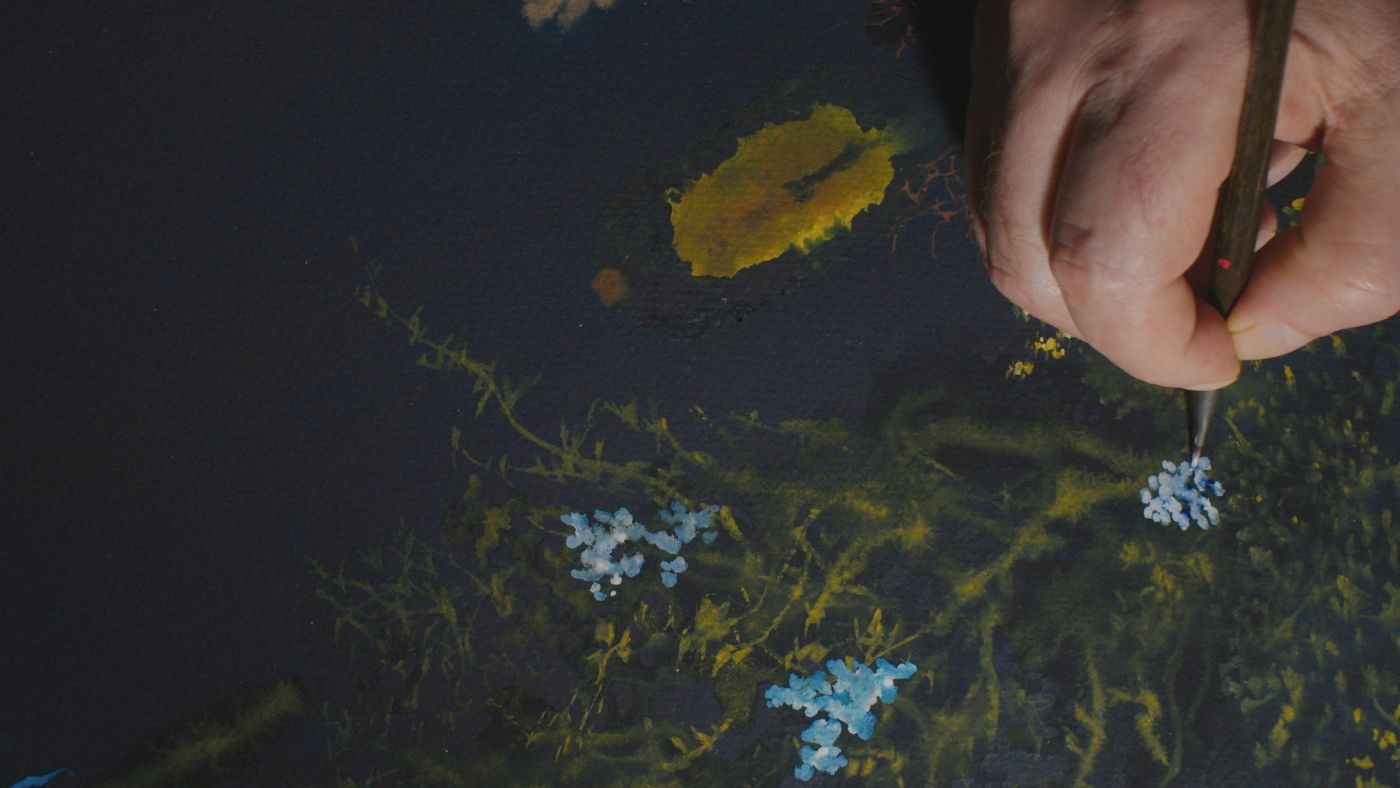For those among you who are unaware, Painting With John is a show created and hosted by John Lurie. Its second season, executive produced by Adam McKay, is currently airing Friday nights on HBO. It is one of the most original works of American art to come down the television pipeline in a long, long time. The show remains fearlessly idiosyncratic in its second season, and totally unlike anything else in the prestige T.V. landscape. Impossible to classify as a comedy, a drama, or anything in between – not that one would want to do something so reductive with a piece of work this intensely singular – Painting With John is entirely uninterested in the moments of grandstanding drama (Game of Thrones), operatic familial backstabbing (Succession), or shock value (Euphoria) offered up by HBO’s other shows. Watching it is an enjoyably shaggy and weirdly beatific experience: each twenty-minute episode is a veritable world unto itself, one that provides a window into Lurie’s inimitable, topsy-turvy mindscape.
Lurie is a former fixture of downtown N.Y.C. cool whose second act in life has been both graceful and entirely unexpected. Lurie, as fans know, rose to prominence in the Big Apple’s grimy glory days. He was a founding member of The Lounge Lizards: a noisy and brilliant avant-garde jazz outfit whose aberrant orchestrations fundamentally changed the sound of a perennial genre. Lurie was also a poker-faced fixture in the canonical early films of Jim Jarmusch, notably Stranger Than Paradise and Down By Law. An artist first and foremost, Lurie never took an easy Hollywood paycheck, even when working on the fringes of the commercial system. He consistently collaborated with boundary-pushing, essential filmmakers like Martin Scorsese (The Last Temptation of Christ), Wim Wenders (Paris, TX), and Abel Ferrara (New Rose Hotel), among others. Odds are, John Lurie has popped up in or even composed original music for one of your favorite under-the-radar movies.
Lurie, in other words, is a renaissance man. He roomed with Jean-Michel Basquiat, released experimental blues music under the inspired pseudonym Marvin Pontiac, and has endured drug habits and several traumatizing health scares. Perhaps the most revealing John Lurie artifact, and the one that most acts as a companion piece to Painting With John, is the analogously titled cult classic program, Fishing With John. Fishing With John is not really a show about fishing in the same way that Painting With John is only tangentially about painting. Sure, both shows basically deliver on what their titles promise: Fishing With John sees Lurie embarking on far-flung fishing expeditions with famous pals like Tom Waits and Matt Dillon, while Painting With John devotes portions of its episodes to sitting with Lurie and listening to him wax poetic about the artistic practice that he’s devoted the latter half of his life to. Fishing With John, it should be said, established a certain playful, unassuming creative blueprint: one that was years ahead of its time, and one that Painting With John mostly follows.
One episode of Fishing With John, for instance, sees Lurie taking Jim Jarmusch on a bleary-eyed, fairly miserable early-morning jaunt to search for shark in Montauk. Another sees Lurie ice-fishing and snuggling with an unusually friendly Willem Dafoe. In both cases, these uneventful adventures are only superficially centered around the hangout activity alluded to in the show’s title. Certain episodes, like a psychedelic two-hander where Lurie and a maniacal Dennis Hopper head off in search for a mythical, whispered-about giant squid, approach levels of legitimate magic realism. Much of Fishing With John is concerned with downtime: the mundane, seemingly throwaway moments of life that nevertheless contain moments of unforced joy.
This unforced joy is at the center of Painting With John, which is as soothing and serene a show as any you’ll currently find on-air. It’s a slightly mellower, more free-form program than Fishing, if no less strange for being an uncut product of Lurie’s one-of-a-kind brain. On paper, the show sounds difficult to find one’s way into; what, with its procession of surreal animated interludes, and the rhapsodically bizarre original jazz music that Lurie sprinkles into each episode. Even if you don’t paint and have no interest in the act of painting, Lurie’s show offers disarming nuggets of life wisdom that can be applied to any number of fields, even those that exist outside the creative arts. The guy’s stubborn commitment to his own beguiling, one-of-a-kind ethos – the unpretentious and utterly unmistakable way in which Lurie views the world and its inhabitants – is its own badge of integrity. If you submit to its tranquil rhythms, Painting With John is as comfortable as a sit-down talk with a wise, funny friend you haven’t seen in far too long.
In the first episode of Painting With John’s second season, Lurie expresses his desire for human beings to, in his words, “shine from within.” This might read as a corny sentiment if it came from the mouth of literally anyone else, but to hear this sardonic, seasoned old wisenheimer toss off something so casually beautiful will warm the cockles of even the coldest of hearts. Painting With John is filled with transfixing, touching moments such as the ones I’ve described, and it is a curiously poignant show for never once asking to be taken seriously.
Often, Painting With John plays like a grab bag of ideas: Lurie is sometimes seen flying drones around the tropical island paradise he calls home, goofing off with his assistants, Nesrin Wolf and Ann Mary Gludd James, or play-acting as a deadpan rancher type named Cowboy Beckett against stunning backdrop collages of his own artwork. All the while, the vibe is unaffected, casual. One gets the sense that Lurie would rather give up everything he’s worked so hard for than create something that could be described as self-serious. As it turns out, there is power in Painting With John’s willingness to be silly, existential, inconsequential, and hypnotic all at the same time. In that regard, the show is truly unlike anything else on television at the moment.
Painting With John is part of a (relatively) new and exciting wave of films and television that prioritize Zen calm and a lightness of touch over the traditional tenets of dramatic storytelling. You see this style in the quiet, literate films of director Hong Sang-Soo, the droll philosophical ruminations of Swedish auteur Roy Andersson, or even the disarmingly gentle anti-comedy of someone like Joe Pera. With Painting With John, and all these previously mentioned artists, the emphasis is less on high drama or stressing out an audience than it is on creating a meditative space where the viewer can simply chill out. For a show where not much really happens, Painting With John is an almost outrageously pleasurable viewing experience, with the combination of Erick Mockus’ unobtrusively beautiful cinematography (Mockus is the show’s primary creative engine along with Lurie, handling producing and editing duties in addition to camerawork) and the intoxicating texture of Lurie’s island home meshing together to create a kind of immersive audio/visual ASMR.
Simply put, Painting With John is chicken soup for your TV-watching soul. There are few shows that will genuinely lift your spirits after a bad day quite like this one. It’s also a low-stakes viewing commitment: each season contains six twenty-minute episodes, meaning you could binge an entire season in a night in the same length of time it would take for you to finish a two-hour film. Selfishly, we are holding out hope that Painting With John isn’t Lurie’s final act. After all, we would watch just about anything “With John”: maybe “Taxes With John,” where Lurie helps you file your W2’s and 1099’s and explains why money is such an intrinsically funny concept, or perhaps “Dancing With John,” where Lurie renders different styles of dance as a kind of demented cartoon spectacle. Concerning a man of so many talents, who’s to say where Lurie will go? All we know is, on the basis of Painting With John, we’ll gladly follow him anywhere.



